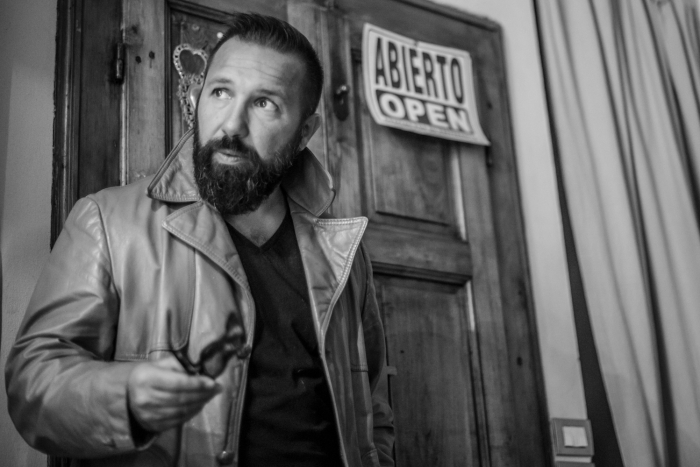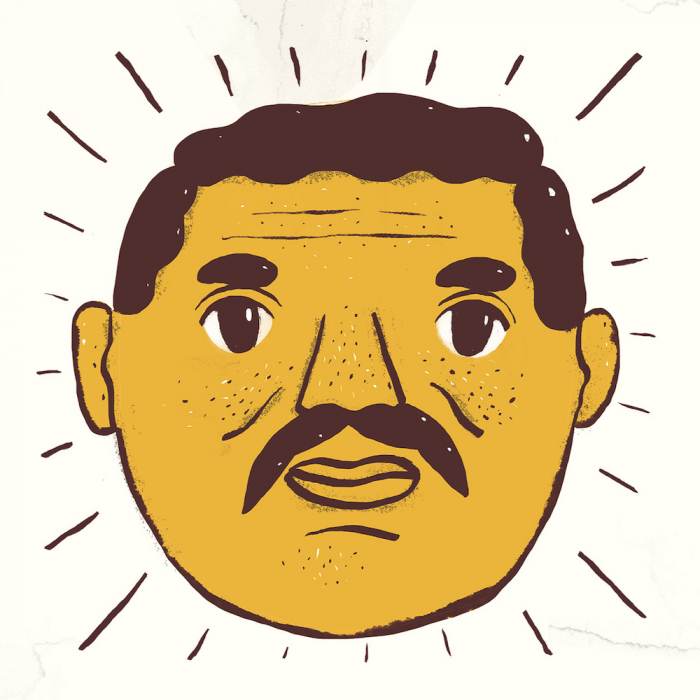Approaching him with a certain reverence, I meet Antonio Gramentieri, from here on called “Don Antonio”, a name suggested by the musician and friend Dan Stuart since “Gramentieri is too long and the vowel and consonant mix is too complex for the international press”. Frequently working abroad, Antonio needed a battle name both ironic and essentially Italian. We meet in his hometown – Modigliana, located in the Forlì-Cesena province (but until 1926 it was in the Florence province), close to the Tuscan border. To the North there is Faenza, the via Emilia is just 20 km away and the sea can be reached in 45 minutes.
An eclectic personality, musician, event organiser, well-known in Italy but focused on the international scene, a true romagnolo with the heart stolen by the States… I think he can give us an across-the-board overview of the “liscio” music genre.
«Born in the 70s, I grew up with a deep love for every kind of American music. Following the American music tracks, I traced back the origins of blues, set in a period when it was still strongly related to African music. I immediately fell in love with that sounds and while my friends, in their twenties at the beginning of the 90s, tried to keep up with everything that was happening around them, I completely ignored the contemporary scene and listened to Mississippi John Hurt and all the following artists.
This immediately set me apart from my fellow musicians, but brought me back to the primal nature of sound, of the timbre. I became pretty good at playing this genre and even founded a festival in Romagna, called Strade Blu, which has become an open workshop, not for me, but for everyone else. When I became pretty skilled, the American musicians started to invite me to play with them as well. After a short time, I noticed that at concerts they arched their eyebrows only when an Italian (or more precisely romagnola) melody slipped in a guitar lick. Dan Stuart himself told me once: “Antonio, you should stop mimicking the failed American musicians, like me, and start playing your own music. Be Italian and the world will be eager to listen to what Italians have yet to say about the sound and its elegance”.
At the time, I had a personal project called Sacri Cuori, and I went to Arizona to record the album (I didn’t want to cut the bonds with my American influences right away!). The album features some members of Calexico, Howe Gelb and the memorable James Chance. The project should have ended with the album release, but it captured the press attention and they started asking me to play it live. That’s how the real Sacri Cuori adventure began, aiming to add a typical “Italian” melodic influence to the American articulation, ranging from the soundtracks of our childhood to the lyricism that characterises the melodic flow of the peninsula. We have released three records, one track has been used for the Volkswagen commercial of the new Passat and we have composed the score for Zoran, my nephew the idiot – an Italian-Slovenian production directed by Matteo Oleotto and distributed in 2013. Then, I reached the point when I wanted to part with the Sacri Cuori experience, therefore I retired to Sicily and recorded Don Antonio, my solo record.
I grew up with a mental map of the world suggested by the maps that we had in our primary schools, where the north-south positions expressed an apparent hierarchy and living in Europe seemed something to boast about on the basis of hypothetical “civilisation” issues. Later on, all the questions I asked myself originated from the “South”: Don Antonio is a project striving to capture a buzzing Italian reality; Africa and Asia are pushing and breaking in, not only into society through migration flows, but also in the staves and the deeply folk music genres. I wanted to employ the sounds that I heard during my trips in a non-hierarchical way, positioning them on the same level, from the coarsest street sounds to the most traditional folk music, riding the “instant” sound wave, originated from this period of transition in the Italian social and ethnic structure. I wanted to do this without intellectualisms, searching songlike melodies and creating “songs without words”.
The Romagna region has always had to deal with profound geographical differences (the romagnoli from the mountains and those from the seaside are extremely different); the Riviera and the growing tourism flows forced this region to face “the other Romagna” and create models of self-presentation and self-representation in line with the tourist’s demand, so that it could be brought home and stored next to the seashell souvenirs. Romagna had to quickly synthetize its identity in a selling formula, a postcard and brochure format, betraying in this way its multifaceted identity and at the same time creating a highly recognisable model. This process inevitably influences our self-perception: if you ask people from Romagna to describe their land, they will answer: “Welcoming, funny, extroverted, great food”. And it’s true! But if we take into consideration a more complex reality… to say the truth we ended up accepting this definition!
On the beach resorts of the Riviera once you could read: “Romagna is the European California”. If you take a look at the advertisements promoting Romagna in the post-war era, the region is depicted as a dreamland, with beautiful women, tasty food, sunshine and flourishing nature. It was a pocket-size California that preserved a post-war provincialism; the tourism industry wasn’t an actual industry yet, but a series of individual experiences that naturally came together, where the importance of “sticking together”, “offering a global self-representation” was already well-established. In this context, the liscio, and then the cheerful music of Raoul Casadei, offered this handy and “exportable” imaginary: easy-going, carefree and happy.
I cannot precisely recall my first encounter with the liscio music: when I was a little boy, in my town Modigliana (5,000 inhabitants) the orchestra played the liscio at every festivity day or celebration.
However, I do remember my “reencounter” with the liscio. In 2000 I was where I am today, in my parents’ house here in Modigliana. From the windows, I could see the kindergarten (now turned into a day centre for the elderly due to the birth rate crisis!) and that night a trio composed by accordion, guitar and drums was playing. I told myself “What a pain!” but then I listened to them playing the whole night, from my window. They reminded me of Booker T. & the M.G.’s. A flowing groove, all suspended in mid-air, the accordion above all, the drummer with a great swing sensibility, almost like a jazz player (a trait that I have observed in many liscio drummers), and the outgoing melody was played with great respect, free of overdone emotional lines… what an eureka moment!
A pure liscio does not exist. Since its origins, this genre has mimicked the jazz orchestra, taking the folk melodies while reproducing the Latin sounds (or the sounds of different parts of the world) and the polka and waltz from the Mitteleuropa. The new discovery of liscio was possible thanks to the acknowledgement that this music genre is based on the central role played by a democratic and sustained melody, backed up by a groove on which you can actually dance. I approached the liscio as a Fausto Papetti firing less at eye level: with respect for its groove and for a cyclic melody typical of the folk dance. Since Sacri Cuori often mixed romantic melodies with danceable grooves live, sometimes people told us that we sounded like Marc Ribot y Los Cubanos Postizos (or the Buena Vista of Ry Cooder) and in Romagna we were told that we sounded like those old-school liscio orchestras.
I was interested in figuring out how to mix the melodic and rhythmic elements of liscio with our sounds. In 2013, Ravenna Festival focused on the reinvention of liscio. We participated with our project “Sacri Cuori Social Club”, with two stars of the Romagna liscio, getting closer to their eighties: Michele Carnevali at the ocarina, sax and clarinet, and Primo Montanari at the accordion. They performed the great liscio classics and we tried to “assist” their musical universe with our timbre. Then we asked them to play the Sacri Cuori’s themes with their inflection. This encounter was not a tribute to the liscio genre in a broader sense: it was an encounter between two generations that could approach the melody and the groove with the same respect, although coming from different backgrounds. We created what I like to hear in music: human beings striving to express the melodies they love.
Years ago when a band chose to play a liscio piece, they often had the modality “make me laugh!” switched on, with distorted guitars and dumb synth noises, as if it was something to keep at a distance and treat as a joke. The 2013 Ravenna Festival was meaningful especially because it showed many people that the liscio genre could be interpreted in various ways, and none of them was coarse. This event opened up several possibilities and ideas regarding this range of sounds and its influences: liscio, just like blues, jazz and rock, became another available colour in the music palette.
I’m particularly close to Castellina-Pasi’s repertoire, he was the first to insert in the liscio a South American emphasis, in a very “salgarian” way: he had never been in South America. And despite it all, despite coming from the province, a small hamlet of the whole world, he knew about the existence of a world music on which you could dance, that could be included in the liscio genre.
I have chosen the liscio song “Ciao Mare” [Bye bye Sea]. This track is about going back to the seaside during wintertime, however it reminds me of my childhood, when I spent the summer at Viserba with my nannies. My parents used to come at the end of the season to take me home and, while we packed our car, I slowly realised that another summer had gone by (and when you’re a kid, summer is a geologic era): “Bye bye Sea” was the ending theme song, careless but nostalgic, to my personal show in which I was a tourist in the Riviera for a couple of months every year».
BYE BYE SEA
(Music by Raoul Casadei, E. Muccioli, A. Pedulli – Lyrics by R. Casadei)
Bye bye, bye bye sea!
Bye bye, bye bye sea!
The white sail is not there anymore
during winter there is a seagull
and the summer of my love
is a distant memory.
She laid down by my side
she burned under the sun
she dozed off in the wind
happy as a baby.
Bye bye, bye bye sea!
Even if it’s freezing cold
I’m here to say hi.
Bye bye, bye bye sea!
Summer memories
awaken in my heart.
The wind brushes away
the memories from the sand
but from the heart, the wind cannot.
Bye bye, bye bye sea!
A flower has blossomed in the sand
a big love in my heart.
She laid down by my side
she burned under the sun
she dozed off in the wind
happy as a baby.
Bye bye, bye bye sea!
Summer memories
awaken in my heart.
Bye bye, bye bye sea!
A flower has blossomed in the sand
a big love in my heart.
The wind brushes away
the memories from the sand
but from the heart, the wind cannot.
Bye bye, bye bye sea!
Bye bye, bye bye sea!


